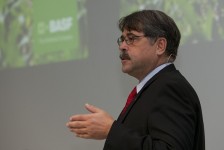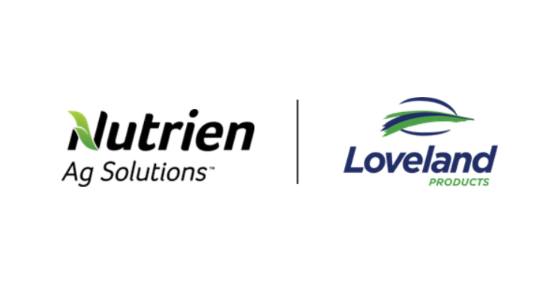BASF’s Global Crop Protection Lead Markus Heldt Talks Asia and the Future of Generics

Markus Heldt, President of BASF’s Crop Protection division, spoke with Farm Chemicals International on Nov. 8 at the company’s headquarters in Ludwigshafen, Germany. Ever-jovial and laid-back, Heldt is a far cry from the picture of an unsmiling, standoffish European corporate kingpin. His career has spanned more than three decades across Europe and the Americas, including São Paulo, Brazil, and more recently BASF’s North American base in Research Triangle Park, North Carolina, before circling back to his native Germany in 2009 to helm the Big 6 company’s global crop protection business. There is little question about Heldt’s role in helping to shape crop protection from the post-Green Revolution 1970s to the $40 billion industry it is today.
Here is an excerpt from the interview:
FCI: What has your experience been working here in Germany versus Brazil and North America?
Heldt: I started as a salesman in Germany, and then I was in London with Shell, responsible for global fungicides. With Cyanamid, I was responsible for Germany, and after the fall of the East European markets, BASF acquired the Cyanamid business. I spent three years in Germany, three years in the US and three years in Brazil, so I would describe myself as a gypsy of this industry. There has been a lot of consolidation, change and challenging times. My wife is always teasing that she is happy that we came back to Germany from Brazil, not directly, but via the US so it gave us a good chance to adjust to a different geography and different culture. We’ve obviously enjoyed these moves – in 31 years of marriage we’ve moved 13 times. It’s been a fascinating journey so far.
FCI: What about your experience in the crop protection industry specifically?
Heldt: When I started my career we had about 75 companies that were still considered at that time R&D-based companies, and now you have six. If you look at the R&D effort, basically there are only two-and-a-half companies left with R&D efforts for crop protection. We’ve seen a tremendous wave of consolidation obviously driven by economies of scale, by R&D funding and the requirements – that has been the biggest change for me personally in this industry.
In terms of technological quantum leaps, personally, I think the introduction of glyphosate is the biggest achievement, very closely followed by fungicides and the success and the change folks have made to farming around the globe. Those were the biggest quantum leaps in my personal career in 30 years.
FCI: Do you think there is going to be another glyphosate?
Heldt: It’s a formidable chemistry, a very competitive chemistry. Everyone is now looking around to find the new glyphosate, but it’s not an easy task.
FCI: What about when resistance becomes more widespread than it is now?
Heldt: I would say now is the perfect time to complement glyphosate, so adding to the tank mix or the premix. Because the solo use of glyphosate on a lot of crops over many acres of cotton, corn and soybeans, especially in the US, is getting more and more difficult. The alternatives are existing chemistries, so we’re developing together with Monsanto dicamba-tolerant soybeans and corn. The double stack of glyphosate and dicamba adds a new mode of action. With innovations we will complement glyphosate in the tank. Fifteen years ago there was a strong belief there was no life for herbicides after glyphosate, but this world has changed significantly in the last five years.
FCI: How worried are you about uncertainty in the global market?
Heldt: In agchem, honestly, I’m not worried at all. Right now it’s looking bright. Commodity prices are high; liquidity is high; demand for innovation is high. The demand-to-stock ratios are very low – the lowest in 25 years – so all those fundamentals are positive for agriculture on a global scale. We also know we live on an island here so if the rest of the world is tanking, we have an impact. But if you look at the last 30 years, the peaks and the declines in the automotive, construction and some of those industries are very significant. Whereas in agriculture it’s going down or up 2 or 3 percent, so it’s a much less cyclical business.
FCI: What about commodity prices? Any concerns on those looking into 2012/13?
Heldt: The main difference I would say when comparing 2008 to 2011 is the stock-to-use ratios are lower. So there is less available ending inventory in corn, soybeans, wheat, which of course is driving attractiveness of the higher prices. The demand, especially in India and China, is sky high. I don’t see anything that is going to change that demand in the mid-term. Thirdly, some of the weather disasters we have to experience, unfortunately, did not result in bumper harvests and thereby driving down the inventories. You look at the US, expected yield data in corn for this year, it’s not so great.
FCI: A couple of earnings reports ago BASF mentioned looking into investments in Brazil but for different chemicals, like polymers. Will there be any new agrichemical investments there?
Heldt: No. But we have for 2012-13 our largest investment effort ever, and it’s mainly for additional capacity in existing plants for backward integration of some of the [AI] building blocks. For Kixor, we had a big investment in our Hannibal, Missouri site in the US, and we’re looking at expanding that capacity, because it’s a mix of increasing capacity for existing chemistry plus putting up new plants for new products to bring into the marketplace. And next week, we have a party here in Ludwigshafen because our Xemium [fungicide] facility has started to operate. We’ve spent about $65 million on that facility.
FCI: Do you already have orders for Xemium – how does that work?
Heldt: Oh, yeah. We’re basically sold out for year one. So there is a very strong demand and great opportunities. Farmers are looking for innovations in the fungicide area as well.
FCI: You said Asia has the most potential for growth. What is the biggest challenge for BASF there?
Heldt: In Asia right now, we have a lot of challenges. The biggest? Finding the right people to make it happen. It’s a very competitive market in China now. I think in India we’re making great progress. These guys are doing a phenomenal job in India. You have to tailor your strategy to the local market. It doesn’t help to do a European approach or a US approach in China. It has to be Asian-tailored strategy. We will invest in Asia in assets to service the local markets because you have to have flexibility and local capabilities to service the Chinas and Indias of this world. China, for us, is insecticides. Asia is very much an insecticide-dominated market – not necessarily our core strength – so that’s up to me to fix over the next couple of years. We will have a more balanced portfolio.
FCI: What do you think the crop protection industry will look like in 10 years?
Heldt: I believe there will be a wave of consolidation of generic companies. Obviously, the ChemChina [acquisition of Makhteshim Agan] will trigger some of the changes. Some of the generic companies are obviously running out of money and running out of cash so there will be a consolidation of the generic side. I wouldn’t mind a consolidation also on the top end of the R&D-based companies. But right now, everyone’s making good money, and the top 6 guys, I think, are hanging in there, and we continue to invest in research and development.
There might be one final wave of consolidation in the agchem industry. There’s definitely pressure on the generic guys, because all of the money that is out of the glyphosate business right now is hurting them as well. So we would be obviously interested to be involved in shaping that consolidation process in the next round. But it will be expensive for R&D-based companies – a big one. It is a very expensive, potential opportunity.
Editor’s Note: In an FCI website exclusive, BASF discusses how Asia will drive $8.25 billion in crop protection sales by 2020.






